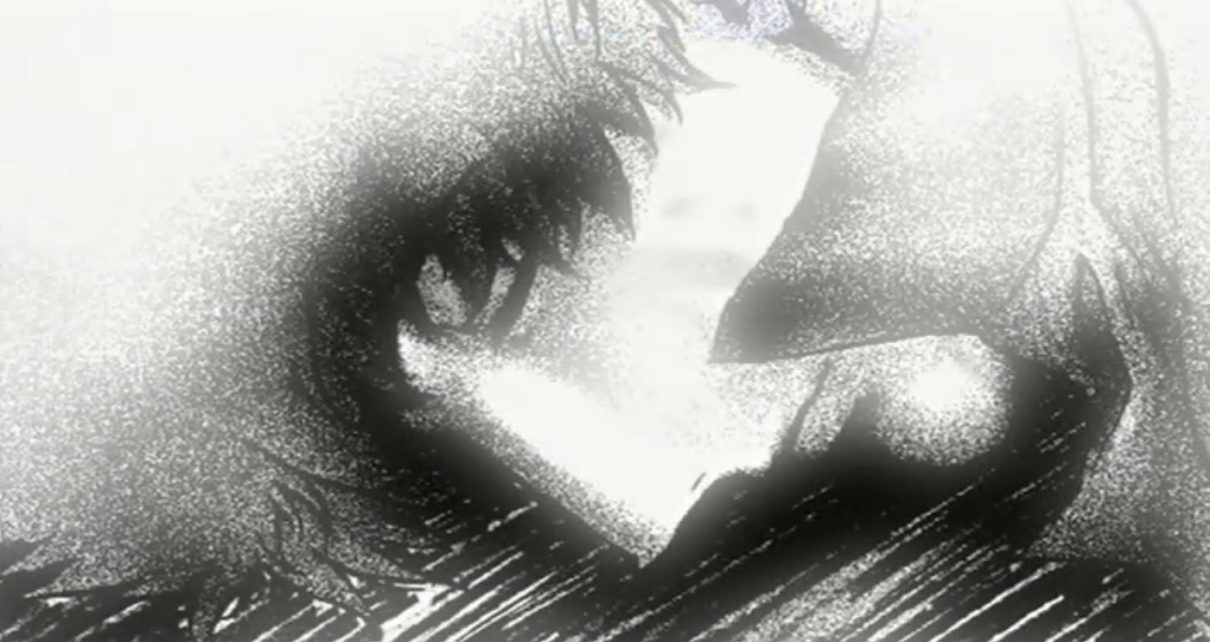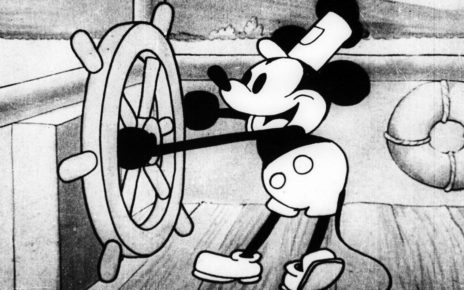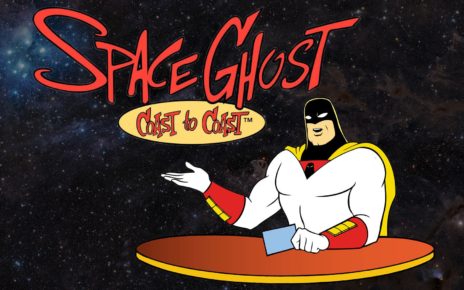
The first time I finished Cowboy Bebop was on Thanksgiving morning in the rear of my family’s silver 2000 Dodge Caravan, squeezed between my two younger brothers as we wound our way along Route 80 from our home on Long Island to Pittsburgh, Pennsylvania, the city where I was born. It left me sobbing in the back seat.
Widely hailed, along with its companion film, as the best anime of all time, Cowboy Bebop is particularly adept at putting the darkest facets of living straight in its sights, and aiming not for the quick kill but the slow bleedout. In fact, that’s exactly how the series ends: In an episode operatic in scope and tenor and blacker than noir in tone, it leaves its main character fallen on the steps of his memory, surrounded by loss, bleeding to death.
That morning was the first of many times I watched Spike Spiegel’s ambiguous (but probable) death scene, but it was by far the most affecting. That evening, I would visit my mother’s grave.
If you like this story, sign up for our newsletter.
I lost my biological mother ten days before I turned five years old. Unlike Spike’s death, hers was quick and neat—a heart attack, at 34, from a syndrome typically carrying a low risk of complications. From the room adjacent, I heard the muffled thud of her body hitting the pinewood floor.
I’ve since misremembered that evening more times than I can count, but here are the things I know: My father was away on business, and his visiting friend John, an outdoorsman particularly qualified to perform CPR, could not revive her; my brother Stephen, not yet two, cried as John tried to breathe life back into her, before family friends came to help and to bring us to my godmother’s house for the night; that evening, in a strange room and unable to sleep, I hallucinated, watching as a full circus paraded through the air between the bed and the door; in the early hours of the morning, finally asleep, my godmother brought the two of us home and laid us in our beds to await my father’s return.
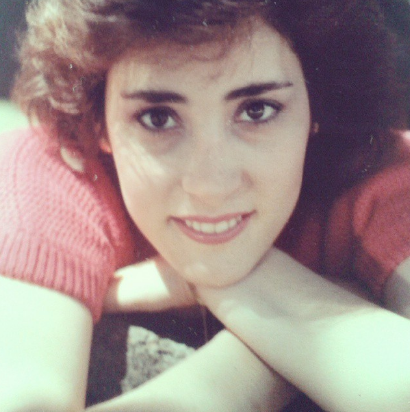
And just before dawn, I wandered downstairs to find the front door cracked open, where my father sat on a white loveseat beneath a black-and-white awning on our brick porch, back from California after a red-eye. I sat in his lap, and he held me silently until the sun had nearly crept out from behind the hills.
“She’s gone,” he told me—or that, perhaps, I’ve misremembered too. He held me tighter, tighter, as we cried together. Then we rose and went inside. I woke Stephen, and Dad began to make breakfast.
My father, in an attempt to protect me from more pain, kept me home from her wake and funeral. For years, whenever I went to similar services — and there were many — I couldn’t cry, couldn’t process the loss. All I could do was imagine that it was my mother’s face on the body in the casket.
Art, though. That did the trick.
Cowboy Bebop is a show standing transfixed at the junction of memory and loss. It obsesses over how the latter haunts us and the former never lets us escape from its influence, even as we try, actively, to forget.
Its protagonist Spike, in particular, exemplifies this. A former member of a crime syndicate who abandoned all ties to the organization after a betrayal (left unexplained until series’ end) by his former partner and lover both, he lives his life as a bounty hunter—or “cowboy,” in the show’s parlance—on his new partner’s spaceship, the Bebop, with the carefree cool of someone with nothing left to lose.
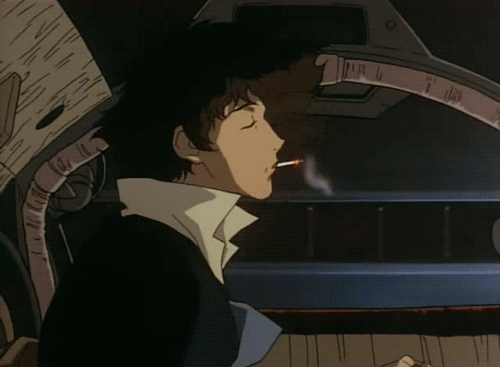
“Whatever happens, happens,” he says once, cigarette dangling from his lip, as his own spacecraft, enshrouded in flames and veering out of control, dips dangerously toward the earth’s atmosphere. Translation: “I am lost and lonely. I am consumed by my loss. I don’t know where to turn, and I don’t know what to do.”
Trauma does that to us. An abrupt loss of any kind, when not handled perfectly (and what’s “perfect,” anyway?), can leave us feeling unmoored and shiftless, hopeless and worthless, even as we know that those we’ve lost would never want us to feel this way. I know, for one, that my mother would never have wanted that for me. That knowledge didn’t change anything. And Spike, for his part, didn’t know. What else to do but run?
Even if the show had not been so clearly preoccupied with the things I have thought about every day of my life—how does one process the enormity of death? what purpose is my faculty of memory if it holds only pain and sadness? can we ever escape the past events that have defined us?—I probably would have loved it. It hits all of my sweet spots: A noirish space western set in a relatively grounded science-fictional universe with gorgeous animation, breakneck fight sequences straight out of ‘70s Chinese cinema, and a swoon-worthy jazz soundtrack? Forget the emotional heft and seemingly custom-tailored-to-me existential musings. I’m in.
But thematically, Bebop went a step beyond most shows on air at the time. One of Cartoon Network’s then-youngling nighttime block Adult Swim’s first-aired shows, Bebop didn’t just break taboos—it shattered them. This was a show from 1998 that put a hermaphroditic (although decidedly not transgendered), and likely LGBTQA, character in a thematically pivotal and emotionally resonant role. It was filled with diversity, influenced by cultures from Japan to Mexico to Turkey, to say nothing of its worldly musical references. And it wasn’t afraid to dig deep into the dark stuff.
For Bebop, the past and its sister, memory, were very dark indeed. Personal history, in this show, really mattered. Which isn’t to say that other shows don’t care about these things too! But Bebop was obsessed with memory, to the point where the opening scene (a flashback, of course) is set to a song played by a music box entitled, I kid you not, “Memory.”
That song’s melody echoes throughout the series in style after style and form after form, until the final episodes reset it, with vocals, as a new piece: “Adieu.” When the series is coming to a close, just as Spike is finally forced to face his past—an action resulting in his likely demise—he, and we, must say goodbye to it all.
It’s as if Spike, before the moment he lost everything, didn’t even exist.
When you’re a survivor of childhood trauma — when you have literally watched your parent die at a very young age — you’re put in this bizarre place where you both remember and can’t, both want to and don’t. I remember my mother dying, but I misremember the specifics of her death. It’s only through retellings from adults who weren’t even there that I’ve been able to discover what actually happened. And it haunts me.
Sometimes, I wish I couldn’t remember her death at all. But everything that happened before it is, naturally, entirely blank. It would have been hard to remember anyway, simply due to my age at the time, but add trauma into the mix? Forget it.
Loved ones have told me stories in which I am a boy of 3 or 4, telling a cashier at the supermarket that I want to be a paleontologist, or playing with my uncle’s dogs at his old house with the buckeye tree. But they’re not memories. They’re not even implanted memories. They’re just stories. In them, I see myself in third-person.
My memory begins, entirely, with the moment of my mother’s death, just as Spike’s memory, in a way, begins with the loss of his former life. We viewers hardly see any of Spike’s history with the crime syndicate, even through flashbacks. We only see the lead-up to his loss, and eventually the loss itself. It’s as if Spike, before the moment he lost everything, didn’t even exist.
Spike can’t, or won’t, remember anything from his past life but for the trauma surrounding its demise, and whenever he does, he tries his best to escape it. I understand this. For many years, I daydreamed my way through life and clung to loved ones in an attempt to run from my mother’s death, like a little boy hallucinating a flying circus in his bedroom and running to his father for help. Anything but confront the damage the past causes, and which my memory—that bitter, tricky thing—has refused to allow me to forget.
The same year as that Thanksgiving trip, or maybe the next, I made a couple of dear friends. Both shared my love for Cowboy Bebop, as did my brother Stephen. We were all in Boy Scouts together and, now that I could drive, we took that Dodge Caravan everywhere. We drove aimlessly around after Scouts on Tuesdays, big garbage night in our little Long Island village, picking up random junk and fooling around with it until we had to go home.
Later, I’d use that same car to get myself to work on summer mornings, and to move myself into college each year. A few weeks ago, it made one of its last journeys before its impending sale for scraps, moving me into a new apartment in Brooklyn. In a way, I’m as attached to that car as any of the bounty hunters on the Bebop are to their own ships. I’ve driven the damn thing for so long that sometimes, the trips blur together as old memories do, like sidewalk chalks of different colors blending in a light but steady rain.
One drive, however, a few years later, I will never forget. That morning, the younger brother of Stephen’s longterm then-girlfriend died of a rare autoimmune disease. He was barely a teenager.
Stephen’s reaction to my mother’s death was different from mine, and both reactions informed our adult personalities. I latch onto people, love as many as I can, hold them smotheringly close for fear of ever losing them, as if loved ones were a barrier built to keep the hurt away. But Steve was pre-verbal when he lost my mother. He couldn’t put into words his need for human connection. So he walled himself off within himself, growing into the perfect picture of a stoic.
I drove us around aimlessly, in silence, as a slew of sad songs played on the speakers. Then I put on a track we knew all too well—the song that plays over the last scene from Cowboy Bebop as Spike endures his bleedout: “Blue.”
That day, for the first time I remember save for the night my mother died, I saw my brother cry. He slammed his fists against the dashboard, crying the big, angry tears of someone trying desperately to comprehend, in vain, a loss that made no sense: the death of someone too young even for a driver’s learning permit.
As the song ended, I pulled to the side of the road and we held each other, each of us sobbing to its lyrical climax:
Everything is clearer now.
Life is just a dream, you know,
that’s never ending.
And once again, in the belly of that beat-up silver Caravan, Cowboy Bebop forced me to stare hard at real loss. This time, though, it wasn’t because I couldn’t confront the pain of my own memory. It was because in that moment, with my brother at my side, I had no choice but to help him confront his.
The best works of art will let you do that, just as truly as the best cars always have names.
My friends and I called mine Bebop.
Thanks for reading The Dot and Line, where we talk about animation.
More personal stories from The Dot and Line:


